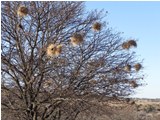PHOWN summaries and recordsVirtual Museum View records in Virtual Museum formatCoverage map for all species Species totals, Nest stats per species and Observer totals Species summary , or General query Observer records, or View VM record Photo of the week, or PHOWN repeats, or PHOWN priorities |
PHOWN record summary
|
Enter new vm record to see a different record and hit 'Go'.
|
Species allocated by Coordinator: Record details entered by participant: (see all records here for this participant) Google map for this record (zoom in and switch to satellite view)
Best: Spectacled Weaver - tatty tube
Photos uploaded by observer



Large photos
791, Spectacled Weaver Ploceus ocularis (see species summary here)Record status ACCEPTED Vm 18685 [on-line data upload (2016-01-11): 188031] Species ploceus ocullaris Observer(s) de Cauwer R Country, town, locus Congo (DRC), Katanga, Kasomeno,
1028DCLocality Luapula River Camp Latitude, longitude -10.8975904565364, 28.5439503192902 [300 m accuracy] Date 2016/1/11 Notes I visited the Island on the Luapula River again to observe these strange nests build by Ocullaris. These birds build their nests in a strange way as if they want to imitate the dry out leaves of Papyrus Plants. As you can see on the pictures, the nests are well camouflaged and very difficult to distinguish from the papyrus's. Most were abandoned, but on one of the pictures where a bird is busy building, you can see a few straws already attached to the short inlet. [see also 17933] Nest count 6 Nest site other
To see this map with all other PHOWN records, click here. Note that the map on this page will load very slowly and probably will only work if you use Chrome as a browser.
History of repeat colony counts
Note: repeats from the same day are not shown.vm Species code Date Nests Notes 18685 791 11/1/2016 6 I visited the Island on the Luapula River again to observe these strange nests build by Ocullaris. These birds build their nests in a strange way as if they want to imitate the dry out leaves of Papyrus Plants. As you can see on the pictures, the nests are well camouflaged and very difficult to distinguish from the papyrus's. Most were abandoned, but on one of the pictures where a bird is busy building, you can see a few straws already attached to the short inlet. [see also 17933] 
Vm 18685










